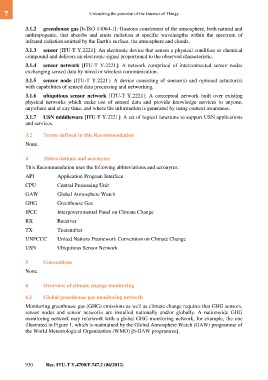Page 944 - Unleashing the potenti al of the Internet of Things
P. 944
7 Unleashing the potential of the Internet of Things
3.1.2 greenhouse gas [b-ISO 14064-1]: Gaseous constituent of the atmosphere, both natural and
anthropogenic, that absorbs and emits radiation at specific wavelengths within the spectrum of
infrared radiation emitted by the Earth's surface, the atmosphere and clouds.
3.1.3 sensor [ITU-T Y.2221]: An electronic device that senses a physical condition or chemical
compound and delivers an electronic signal proportional to the observed characteristic.
3.1.4 sensor network [ITU-T Y.2221]: A network comprised of interconnected sensor nodes
exchanging sensed data by wired or wireless communication.
3.1.5 sensor node [ITU-T Y.2221]: A device consisting of sensor(s) and optional actuator(s)
with capabilities of sensed data processing and networking.
3.1.6 ubiquitous sensor network [ITU-T Y.2221]: A conceptual network built over existing
physical networks which make use of sensed data and provide knowledge services to anyone,
anywhere and at any time, and where the information is generated by using context awareness.
3.1.7 USN middleware [ITU-T Y.2221]: A set of logical functions to support USN applications
and services.
3.2 Terms defined in this Recommendation
None.
4 Abbreviations and acronyms
This Recommendation uses the following abbreviations and acronyms:
API Application Program Interface
CPU Central Processing Unit
GAW Global Atmosphere Watch
GHG Greenhouse Gas
IPCC Intergovernmental Panel on Climate Change
RX Receiver
TX Transmitter
UNFCCC United Nations Framework Convention on Climate Change
USN Ubiquitous Sensor Network
5 Conventions
None.
6 Overview of climate change monitoring
6.1 Global greenhouse gas monitoring network
Monitoring greenhouse gas (GHG) emissions as well as climate change requires that GHG sensors,
sensor nodes and sensor networks are installed nationally and/or globally. A nationwide GHG
monitoring network may interwork with a global GHG monitoring network, for example, the one
illustrated in Figure 1, which is maintained by the Global Atmosphere Watch (GAW) programme of
the World Meteorological Organization (WMO) [b-GAW programme].
930 Rec. ITU-T Y.4700/F.747.2 (06/2012)

